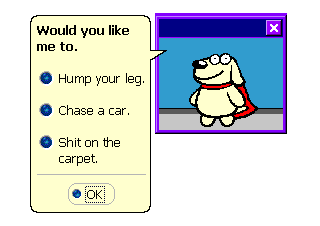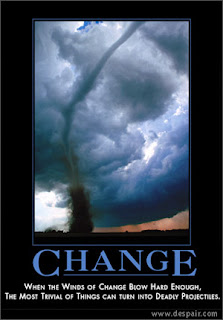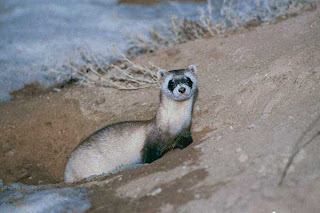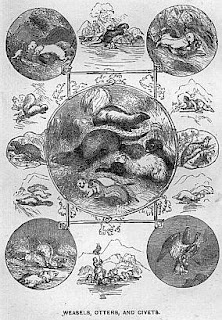 Found this on Craigslist, this so represents some of the people and their attitudes about pets -
Found this on Craigslist, this so represents some of the people and their attitudes about pets -
Hello: You have reached 123-4567, Tender Hearts Rescue.
Due to the high volume of calls we have been receiving, please listen closely to the following options and choose the one that best describes you or your situation:
Press 1 if you have a 10-year-old dog and your 15-year-old son has suddenly become allergic and you need to find the dog a new home right away.
Press 2 if you are moving today and need to immediately place your 150 pound, 8-year-old dog.
Press 3 if you have three dogs, had a baby and want to get rid of your dogs because you are the only person in the world to have a baby and dogs at the same time.
Press 4 if you just got a brand new puppy and your old dog is having problems adjusting so you want to get rid of the old one right away.
Press 5 if your little puppy has grown up and is no longer small and cute and you want to trade it in for a new model.
Press 6 if you want an unpaid volunteer to come to your home TODAY and pick up the dog you no longer want.
Press 7 if you have been feeding and caring for a "stray" for the last three years, are moving and suddenly determine it's not your dog.
Press 8 if your dog is sick and needs a vet but you need the money for your vacation.
Press 9 if you are elderly and want to adopt a cute puppy who is not active and is going to outlive you.
Press 10 if your relative has died and you don't want to care for their elderly dog because it doesn't fit your lifestyle.
Press 11 if you are calling at 6 a.m. to make sure you wake me up before I have to go to work so you can drop a dog off on your way to work.
Press 12 to leave us an anonymous garbled message, letting us know you have left a dog in our yard in the middle of January, which is in fact, better than just leaving the dog with no message.
Press 13 if you are going to get angry because we are not going to take your dog that you have had for fifteen years, because it is not our responsibility.
Press 14 if you are going to threaten to take your ten year old dog to be euthanized because I won't take it.
Press 15 if you're going to get angry because the volunteers had the audacity to go on vacation and leave the dogs in care of a trusted volunteer who is not authorized to take your personal pet.
Press 16 if you want one of our PERFECTLY trained, housebroken, kid and cat friendly purebred dogs that we have an abundance of.
Press 17 if you want us to take your dog that has a slight aggression problem, i.e. has only bitten a few people and killed your neighbor's cats.
Press 18 if you have already called once and been told we don't take personal surrenders but thought you would get a different person this time with a different answer.
Press 19 if you want us to use space that would go to a stray to board your personal dog while you are on vacation, free of charge, of course.
Press 20 if it is Christmas Eve or Easter morning and you want me to deliver an eight week old puppy to your house by 6:30 am before your kids wake up.
Press 21 if you have bought your children a duckling, chick or baby bunny for Easter and it is now Christmas and no longer cute.
Press 22 if you want us to take your female dog who has already had ten litters, but we can't spay her because she is pregnant again and it is against your religion.
Press 23 if you're lying to make one of our younger volunteers feel bad and take your personal pet off your hands.
Press 24 if your cat is biting and not using the litter box because it is declawed, but are not willing to accept the responsibility that the cat's behavior is altered because of your nice furniture.
Press 25 if your two year old male dog is marking all over your house but you just haven't gotten around to having him neutered.
Press 26 if you previously had an outdoor only dog and are calling because she is suddenly pregnant.
Press 27 if you have done "everything" to housebreak your dog and have had no success but you don't want to crate the dog because it is cruel.
Press 28 if you didn't listen to the message asking for an evening phone number and you left your work number when all volunteers are also working and you are angry because no one called you back.
Press 29 if you need a puppy immediately and cannot wait because today is your daughter's birthday and you forgot when she was born.
Press 30 if your dog's coat doesn't match your new furniture and you need a different color or breed.
Press 31 if your new love doesn't like your dog and you are too stupid to get rid of the new friend (who will dump you in the next month anyway) instead of the dog.
Press 32 if you went through all these 'options' and didn't hear enough. This press will connect you to the sounds of tears being shed by one of our volunteers who is holding a discarded old dog while the vet mercifully frees him from the grief of missing his family.![]() ferrets
ferrets
Thursday, July 24, 2008
Craigslist and Pets
Posted by
Susie
0
comments
![]()
![]()
Labels: craigslist
Saturday, July 19, 2008
Black Footed Ferret and the Sixth Great Extinction

The extinction of the black footed ferret along with many other species and impacts upon earth, primary cause - humans, government, and greed
Human beings are currently causing the greatest
mass extinction of species since the extinction of
the dinosaurs 65 million years ago. If present trends
continue one half of all species of life on earth will
be extinct in less than 100 years, as a result of
habitat destruction, pollution, invasive species,
and climate change.
Threats to the Ferret
Loss of habitat is the primary reason black-footed ferrets remain near the brink of extinction. Conversion of grasslands to agricultural uses, widespread prairie dog eradication programs and plague have reduced ferret habitat to less than 2 percent of what once existed. Remaining habitat is now fragmented, with prairie dog towns separated by great expanses of cropland and human development. Many other sensitive species such as burrowing owls, mountain plovers, golden eagles, swift fox, and ferruginous hawks are strongly linked to this habitat for their survival. Many of these species are following the ferret's fate, and may soon require further conservation efforts to ensure their survival.
The Prairie Ecosystem
The North American prairie is one of the most endangered ecosystems on earth--perhaps even more endangered than the South American rain forest or the old growth forests of the American northwest. The grasslands of North America began to form about 20 million years ago, but in some areas, up to 99 percent of the prairie has been destroyed in just the last 125-150 years.
The survival of the black-footed ferret is inextricably linked to the survival of the prairie dog. Ferrets live in prairie dog burrows and feed on them almost exclusively.
As native prairie was converted to agricultural use, habitat was destroyed and humans poisoned prairie dogs out of fear that the rodents competed with their livestock for grass. As a result, the 247 million acres of grasslands once occupied by prairie dogs has been reduced by 98 percent. Besides continued poisoning, recreational shooting of prairie dogs is growing in popularity. With few regulations and no bag limits, shooters often kill hundreds of prairie dogs in a single day, drastically reducing their numbers. Finally, sylvatic plague--a disease spread by fleas to which prairie dogs have no natural immunity--is perhaps the greatest threat to their existence today.
Journal of Mammalogy, 89(1):87–96, 2008
The black-footed ferret is a small-bodied mustelid whose modern distribution is tightly associated with prairie dogs. Black-footed ferrets live in the burrow systems of prairie dogs, which are their primary prey . Systematic eradication of prairie dogs throughout the 20th century led to the near extinction of this highly endangered mustelid. Phylogenetic evidence suggests that black-footed ferrets evolved from their sister taxon, Mustela eversmanii, and
crossed the Beringian land bridge sometime between 2 million and 500,000 years ago (O’Brien et al. 1989). The earliest fossil evidence of black-footed ferrets in North America is mid-Pleistocene (~800,000 years ago—Anderson 2004; Owen et al. 2000). Wisconsinian fossil records (30,000–14,500 years ago) indicate the persistence of black-footed ferrets during the last glacial maximum, and they are described from southern Columbia Basin, west of the Continental Divide, as well as from the Great Plains east of the Continental Divide (Anderson et al. 1986). For species with modern distributions east and west of the Rocky Mountains, it appears that populations on either side of the Continental Divide were isolated from one another to the extent that they formed distinct genetic lineages.
FROM UNION OF CONCERNED SCIENTISTS:
Evidence of Political Interference
Systematic Interference with Science at Interior Department Exposed
Recently obtained documents demonstrate that former Deputy Assistant Secretary Julie MacDonald and other high-ranking political appointees within the U.S. Fish and Wildlife Service (FWS) at the Department of the Interior have systematically distorted, manipulated, and misused the scientific process prescribed by the Endangered Species Act.
Science Regarding Endangered Species Act Manipulated
A wide array of scientists, government officials, and environmental groups has charged that the George W. Bush administration is engaged in a systematic attempt to weaken the Endangered Species Act.1 The administration has supported pending amendments before Congress that would make it harder to list threatened species, in particular by greatly limiting the use of population modeling.2 This technique is the most credible way to assess the likelihood that a small species population will survive in a given habitat.3
Perhaps most troubling, however, has been the way in which the Bush administration has suppressed or even attempted to distort the scientific findings of its own agencies to further its political agenda. These actions go well beyond a policy fight over the Endangered Species Act and represent a manipulation of the scientific underpinnings of the policy-making process itself.
U.S. Fish & Wildlife Service Survey Summary
In 2005, the Union of Concerned Scientists (UCS) and Public Employees for Environmental Responsibility (PEER) distributed a 42-question survey to more than 1,400 USFWS biologists, ecologists, botanists and other science professionals working in Ecological Services field offices across the country to obtain their perceptions of scientific integrity within the USFWS, as well as political interference, resources and morale. Nearly 30 percent of the scientists returned completed surveys, despite agency directives not to reply—even on personal time.
Negative Effect on Wildlife Protection
While a majority of the scientists indicated that agency "scientific documents generally reflect technically rigorous evaluations of impacts to listed species and associated habitats," there is evidence that political intrusion has undermined the USFWS’s ability to fulfill its mission of protecting wildlife from extinction.
- Three out of four staff scientists and even higher proportions of scientist managers (78 percent) felt that the USFWS is not "acting effectively to maintain or enhance species and their habitats, so as to avoid possible listings under the Endangered Species Act;"
- For those species already listed as threatened or endangered under the ESA, more than two out of three scientists (69 percent) did not regard the USFWS as effective in its efforts toward recovery of those listed species;
- Nearly two out of three scientists (64 percent) did not feel the agency "is moving in the right direction;" and
- More than two-thirds of staff scientists (71 percent) and more than half of scientist managers (51 percent) did not "trust USFWS decision makers to make decisions that will protect species and habitats."
Oversight of Endangered Species Science
One of the great strengths of the Endangered Species Act is its foundation in robust scientific principles and its reliance on the best available science. But mounting evidence shows that political interference is undermining the implementation and enforcement of protections for imperiled species.
n May 2008 testimony before the U.S. House of Representatives Natural Resources Committee, UCS Senior Scientist Francesca Grifo described how the U.S. Fish and Wildlife Service has distorted science and changed the way it uses scientific information to stack the deck against endangered and threatened species. Dr. Grifo’s testimony (oral, written) recommended several reforms needed to restore scientific integrity to the federal policy making process.
Union of Concerned Scientists to Congress: Politics Trumps Science at U.S. Fish and Wildlife Service
WASHINGTON (May 8, 2007)—The title of the May 9 House Resources Committee hearing poses a question: "Endangered Species Act Implementation: Science or Politics?"
The unfortunate answer is all too often "politics," according to the Union of Concerned Scientists (UCS).
The hearing comes on the heels of a scathing Department of Interior Inspector General report that chastised former Deputy Assistant Secretary Julie MacDonald for distorting U.S. Fish and Wildlife Service (FWS) scientific documents to prevent the protection of several highly imperiled species. Just last week, MacDonald resigned her post.
Bush Administration FY06 Budget—Highlights and Lowlights
President George W. Bush recently released his comprehensive budget request for fiscal year 2006 (FY06). The administration has slightly reduced funding for the missile defense system and did provide significant cuts in new nuclear weapons requests while allowing for an increase in nuclear nonproliferation programs. And while the administration’s budget for renewable energy resources, clean vehicle tax credits, hydrogen energy research, and cleaner school buses address some of the nation’s energy and transportation needs, it fails to provide the long-term size and scope required to ensure a cleaner, more secure energy future. The Bush budget is also replete with a number of anti-environmental requests. Funding cuts for forest fire protections and endangered species, and a backdoor attempt to open the Arctic National Wildlife Refuge to oil and gas drilling, are just a few examples of regressive policy initiatives within this budget. UCS will oppose cuts to many of these programs and will seek to support policies for a safer, more sustainable world.
The proposed budget decreases overall funding for endangered species programs by $3 million. Among the cuts are funds for candidate species conservation, which are cut by 11 percent, and funds for recovery programs, which are cut by eight percent. The budget does propose a small increase in funding for listing and consultation. However, the listing budget of $18.1 million is still well short of the $153 million wildlife officials have said is needed to study the more than 250 species on the Fish & Wildlife Services' candidate list for endangered species.
Bush Administration FY07 Budget—Highlights and Lowlights
President George W. Bush recently released his comprehensive budget request for fiscal year 2007 (FY07). The FY07 request takes advantage of the budget deficit to cut a number of important environmental programs including several initiatives that would actually save taxpayers money. While there are a few positive developments, overall the budget fails to provide America with the means to build a cleaner, more secure future.
Endangered Species
The proposed budget decreases overall funding for endangered species programs by $6.7 million. Though the budget calls for slight increases for listing and consultation, funding for endangered species recovery is $7.6 million below 2006 levels. The budget also cuts funding for national wildlife refuges, even as the U.S. Fish and Wildlife Service is desperately in need of more funds to repair more than $200 million in damage to refuges from last year's Gulf Coast hurricanes.
WildEarth Guardians Seeks Federal Protection for 681 Western Species
Endangered species inaction a violation of ESA
Santa Fe, NM—On March 19, WildEarth Guardians filed suit in Washington, DC against the U.S. Fish and Wildlife Service (Service) seeking protection of 681 plant and animal species under the Endangered Species Act. The suit challenges the Service's failure to issue findings on two petitions filed by WildEarth Guardians last summer which requested protection of 681 critically imperiled species across twelve western states.Yesterday, the Washington Post reported WildEarth Guardians' lawsuit and the broader problem of the Bush administration's low rate of listing endangered species. The Post story describes how the Bush administration has dismissed scientific advice and reversed long-standing policies in order to avoid protecting imperiled species.
"Tragically, 80% of the endangered species in the U.S. are not protected under the Endangered Species Act," stated Dr. Nicole Rosmarino of WildEarth Guardians. "Under the Bush administration, one of the biggest threats facing species on the brink of extinction in the U.S. is the very agency that is supposed to be protecting them — the Fish and Wildlife Service," continued Rosmarino.
WildEarth Guardians' petitions cite the current human-caused extinction crisis, with 6,000-9,000 species estimated at risk of extinction in the U.S., as a rationale for federal protection of all critically imperiled and imperiled species across the twelve western states in the Service's Southwestern and Mountain-Prairie Regions. Nationwide, only 1,351 U.S. species are federally protected (listed under the Endangered Species Act).
Since '01, Guarding Species Is HarderEndangered Listings Drop Under Bush
With little-noticed procedural and policy moves over several years, Bush administration officials have made it substantially more difficult to designate domestic animals and plants for protection under the Endangered Species Act.
Declining Protection
President George W. Bush's administration has protected fewer animal and plant species under the Endangered Species Act than previous presidential administrations.Colorado's Black-footed Ferrets Saved from Drilling Threat
Review Board Says BLM Ignored Endangered Species Impacts From Oil and Gas Leases
DENVER — Based on a decision made public late last week, Colorado's endangered black-footed ferrets will be protected from oil and gas drilling — for now. The Bureau of Land Management's (BLM) own internal review board, the Interior Board of Land Appeals (IBLA), overturned the BLM's May 2006 sale of oil and gas drilling leases in an area where endangered black-footed ferrets have been reintroduced in Colorado.
Despite the U.S. Fish and Wildlife Service (FWS) urging that ferret habitat be excluded from the lease sale, the BLM went ahead and sold drilling leases to the highest bidder. The ferrets, considered North America's most endangered species, were reintroduced to Colorado in 2001 and an active program to recover populations to self-sustaining levels is underway.
The IBLA found that the BLM broke the law by selling the leases "without any record evidence that it ever responded to or even considered FWS's views." The board found the action illegal because "an expert sister agency urged that leasing be deferred" in the ferret habitat, but BLM did not "explain its rejection of FWS' views. BLM again failed to consider new information". The decision cited the Service's warning that "Introduction of an additional disturbance factor at this critical stage in the establishment of ferrets in this area could prove to be detrimental."
"Many people have worked very hard to restore the ferret to Colorado, but even our most endangered wildlife has been offered up by the BLM in the rush to drill," said Erin Robertson of Center for Native Ecosystems. "Now the BLM must reconsider before allowing the home of Colorado's only black-footed ferrets to become a wellfield."
The Pleistocene-Holocene Event:
The Sixth Great Extinction
The Crisis
A few biologists—including geneticist Michael Soulè (who was later the founder of the Society for Conservation Biology) and Harvard's famed E. O. Wilson—put these worrisome anecdotes and bits of data together. They knew, through paleontological research by others, that in the 570 million years or so of the evolution of modern animal phyla there had been five great extinction events. The last happened 65 million years ago, at the end of the Cretaceous when dinosaurs became extinct. Wilson and company calculated that the current rate of extinction is one thousand to ten thousand times the background rate of extinction in the fossil record. That discovery hit with all the subtlety of an asteroid striking Earth: RIGHT NOW, TODAY, LIFE FACES THE SIXTH GREAT EXTINCTION EVENT IN EARTH HISTORY. The cause is just as unsettling and unprecedented: eating, manufacturing, traveling, warring, consuming, and breeding by six billion human beings. For the first time in the history of life on Earth, one species is killing countless others. For the first time, one species—Homo sapiens; that's us—is waging a war against Nature. The crisis we face is biological meltdown. Wilson (1992) warns that the proportion of species driven to extinction “might easily reach 20 percent by 2022 and rise as high as 50 percent or more thereafter.” Soulè (1980) has said that soon the only large mammals left will be those we consciously choose to protect; that, “[The twentieth] century will see the end of significant evolution of large plants and terrestrial vertebrates in the tropics.” He writes (1996), “The end of speciation for most large animals rivals the extinction crisis in significance for the future of living nature. As [Bruce Wilcox and I] said in 1980, ‘Death is one thing, an end to birth is something else.’”
Posted by
Susie
0
comments
![]()
![]()
Wednesday, July 16, 2008
Ferrets in Transport to Pet Stores
I am waiting for them. It is seven in the morning in the middle of September. I listen for the planes outside, the whining of their engines rising as they taxi closer to where I'm working. I'm a security guard at one of the major airline's air cargo centers. I know they're coming, but I don't know exactly which days they'll arrive. I keep my eyes open, watching for them. There are just a few people here with me. There are always just a few people here during working hours, labeling boxes, stacking boxes, driving forklifts, or sometimes just watching TV between arrivals. To these people, what I'm waiting for are just packages, but to me they are so much more.
Also read this post, ferret organizations had tried to change the minimun age for transport several years ago, but it didn't pass. I hope that it passes this year.
Posted by
Susie
0
comments
![]()
![]()
Labels: baby ferrets, government, pet stores selling ferrets
Tuesday, July 15, 2008
Black-Footed Ferrets hit by Plague

This is so sad, Black-footed ferrets in South Dakota struck by Sylvatic Plague
WALL, S.D. — A colony that contains nearly half of the black-footed ferrets in the country and which biologists say is critical to the long-term health of the species has been struck by plague, which may have killed a third of the 300 animals.
Losing this population to the plague would be a blow for the entire ferret recovery program and personally heartbreaking, said Mr. Livieri, who has worked for 13 years to restore this population south of Badlands National Park. He started with the National Park Service, then worked for the Forest Service and now cobbles together financing for his own nonprofit organization, Prairie Wildlife Research.
For now, the race is on to protect the heart of the ferret population. Mr. Livieri, often working by himself, drives from his home in Wellington, Colo., six hours away, and spends a week or two at a time scouring the prairie all night in hopes of injecting all of the ferrets.
Treating ferrets, though, is only half of the equation. Enough prairie dogs need to survive the plague to keep the ferrets from starving to death. One ferret eats 125 to 150 prairie dogs a year.
A decision by the Forest Service on whether to poison prairie dogs on land that has no ferrets, but is suitable habitat for them, is due out soon. A decision on whether to poison prairie dogs in ferret habitat is being delayed, said the under secretary of agriculture, Mark Rey, to see how the spread of the plague plays out. “We’ll see how big it is, how far it is likely to spread and how many prairie dogs we have left as it runs its course,” Mr. Rey said. “Prudence dictates we collect this information.”
Save a Population of Ferrets
From Prairie Wildlife Research News:
The battle against plague in Conata Basin continues. It appears that as much as 9,000 acres of the 31,000 acres of prairie dogs may be affected. We won’t know until late fall how much the black-footed ferret population has been impacted. By that time I will have completed my counts of BFFs and we will have a more accurate assessment of the damage done by plague.
I continue to lead a small crew in capturing BFFs for vaccination by the National Wildlife Health Center. If we don’t capture these BFFs they will not be vaccinated. To date we have captured and vaccinated 43 adult BFFs. We will capture and vaccinate the kits but right now they are not big enough to capture and many remain below ground. By mid-August we will be capturing kits. Other crews continue to dust prairie dog burrows to kill fleas which can spread plague. It is a laborious task that will persist throughout the summer.
Plague Q & A
Travis Livieri is executive director of Prairie Wildlife Research and holds BS and MS degrees in wildlife management. He has worked on the North American prairies for 13 years to restore the endangered black-footed ferret.
Sylvatic plague has reached the Conata Basin, an area of South Dakota that was a previous safe haven for black-footed ferrets and one of the most successful sites for reintroducing the endangered black-footed ferret into the wild. Travis Livieri is one of the people working to save the black-footed ferrets, also known as BFFs.
Travis Livieri - Saving The Black-Footed Ferrets
His Blog![]() ferrets
ferrets
Posted by
Susie
0
comments
![]()
![]()
Labels: black footed ferret
Thursday, July 3, 2008
Ask the Department of Defense to End Live Animal Use in Medical Student Courses
Ferrets are being used to teach future pediatricians to intubate infants by the DOD. An intubation lab using live ferrets offered to third-year medical students (also offered at Wilford Hall). Ferrets can suffer fatal injuries during these labs.
A DOD directive renewed in 2005 mandates that non-animal alternatives be used if they exist. There are non-animal teaching methods that achieve the educational goals for all five animal labs mentioned above. Many of these alternatives are currently in use at the National Capital Area Medical Simulation Center, a state-of-the-art simulation center operated by USUHS.
PCRM (Physicians Committee for Responsible Medicine)
Please help end the use of live animals for medical student training at U.S. military facilities. Live animals are used in medical student courses at the Uniformed Services University of the Health Sciences (USUHS) in Bethesda, Md., and Wilford Hall Medical Center at Lackland Air Force Base in San Antonio. They may also be used at other military facilities. PCRM filed a petition for enforcement with the Department of Defense (DOD) on July 2, 2008, asking for an end to this animal use.
Please call, e-mail, fax, or write a letter to USUHS president Charles L. Rice, M.D., and the dean of the medical school Larry W. Laughlin, M.D., Ph.D., and politely ask them to end the school’s live animal lab program. Being polite is the most effective way to help these animals. Send an automatic e-mail>
Med School Is Asked to Stop Animal Use
The U.S. military's medical school in Bethesda is drawing criticism from a coalition of physicians and military officers for using live animals in some medical procedures, such as surgeries, a practice many medical schools have long abandoned.
Students and faculty at the Uniformed Services University of the Health Sciences insert breathing tubes in live ferrets to practice intubation of human infants, and they perform surgeries on live pigs, according to a petition for enforcement to be filed today with the Department of Defense.
The petition alleges that the military's use of animals in medical classes "inherently and unavoidably causes pain, distress, and suffering to those animals."
Group says no more animals at military med schoolSAN ANTONIO — A nonprofit group on Wednesday petitioned the head of the Army to end the use of live pigs and ferrets for surgical teaching and other instruction at the nation's military medical school, a practice the group says violates military regulations.
The Physicians Committee for Responsible Medicine petitioned Secretary of the Army Pete Geren, who is charged with implementation of the Defense Department regulation on use of laboratory animals, to end the use of live animals at the Uniformed Services University of Health Sciences.
USUHS is a medical school that graduates about 160 military and public health doctors per year. Currently, live animals are used for surgical and other instruction in San Antonio and at the school's main site in Bethesda, Md.
A military regulation, last updated in 2005, dictates that alternative methods to the use of animals be considered and used if they produce scientifically valid or equivalent results.
Dr. John Pippin, PCRM's senior medical and research adviser, said pigs are being used for surgical instruction and ferrets are being used to teach future pediatricians to intubate infants.
Such uses for live animals are no longer necessary because simulators offer equal or better instruction, he said. Only eight of the nation's 126 medical schools still use live animals, a practice that has been increasingly phased out with the growth in high-tech alternatives, he said.In U.S., Few Alternatives To Testing On Animals
For FDA’s Andy, The Dog Days Of Summer
Posted by
Susie
0
comments
![]()
![]()
Labels: animal model, government








